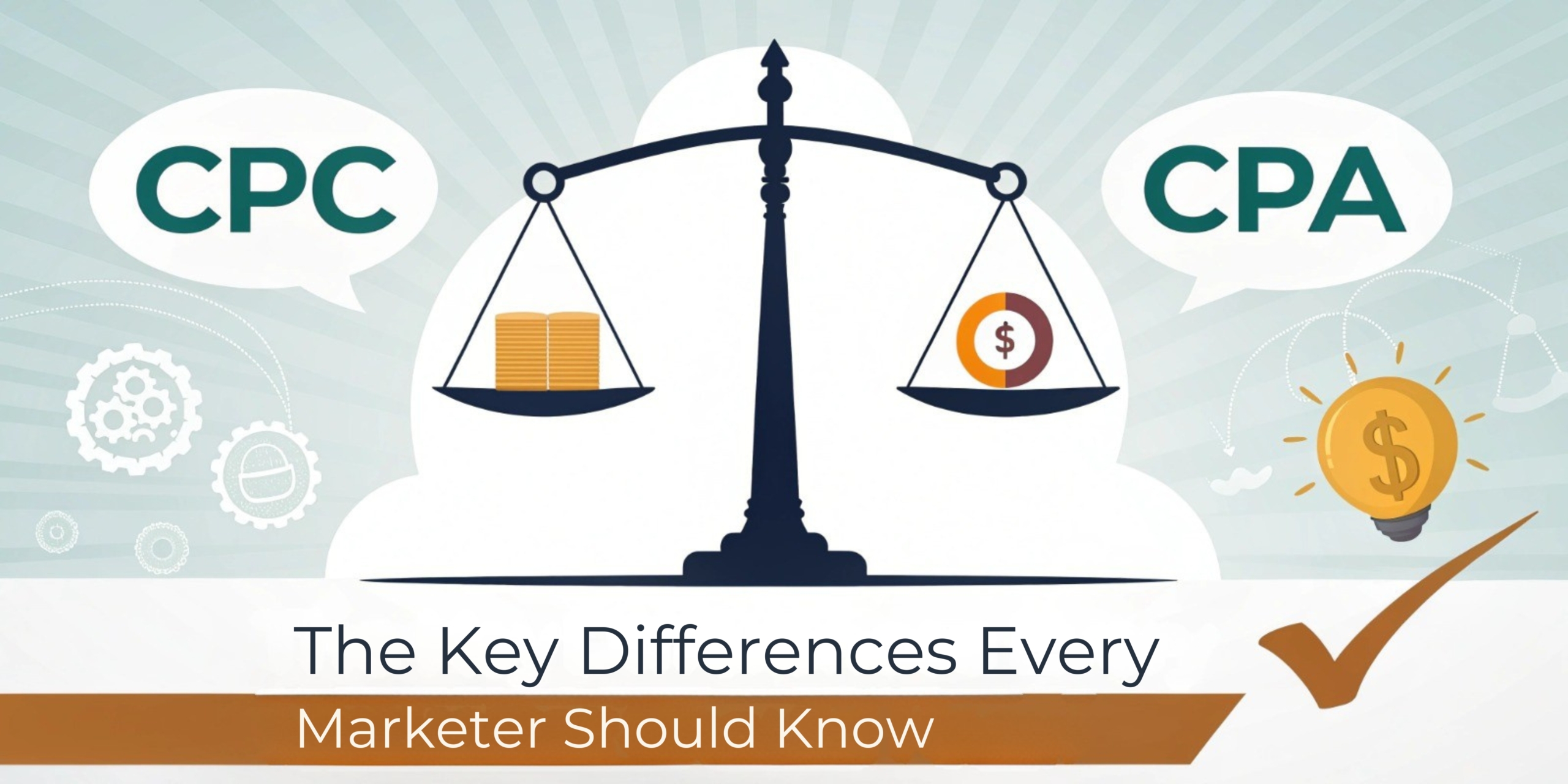Introduction
In the ever-evolving world of digital marketing, advertisers and marketers constantly seek the most efficient way to generate leads, increase conversions, and maximize their return on investment (ROI). Two of the most commonly used advertising models are CPC (Cost Per Click) and CPA (Cost Per Acquisition). While both models serve as powerful tools for online advertising, understanding their key CPC vs CPA is crucial for marketers to make informed decisions. Both CPC and CPA have their own advantages and drawbacks, and knowing when to use each model can be the key to running a successful advertising campaign. Some businesses prioritize website traffic, while others focus on lead generation and sales. This guide will break down the difference between CPC and CPA, their pros and cons, and when to use each for optimal campaign performance.
What is CPC (Cost Per Click)?
Cost Per Click (CPC) is a pricing model where advertisers pay a fee each time someone clicks on their ad. This model is widely used in digital marketing platforms such as Google Ads, Facebook Ads, and Bing Ads.
How CPC Works:
- Advertisers bid on keywords relevant to their target audience.
- Ads appear on search engines or social media platforms.
- Advertisers pay when users click on the ad, regardless of whether they convert.
Key Features of CPC Advertising:
- Advertisers are charged only when a user clicks on their ad.
- CPC campaigns focus on driving traffic to a website or landing page.
- The cost per click varies depending on factors such as competition, industry, and keyword relevance.
- CPC is commonly used for search engine advertising (Google Ads) and social media campaigns.
CPC Formula:
CPC= Total Ad Spend / Total Clicks
For example, if you spend $ 100 and get 200 clicks, your CPC is $ 0.50 per click.
Pros of CPC Advertising:
- High Control: Marketers have control over their budget and can adjust their bids to maximize ROI.
- Immediate Traffic: CPC campaigns can quickly drive visitors to a website.
- Measurable Results: Performance metrics like click-through rate (CTR) and conversion rate help optimize campaigns.
Cons of CPC Advertising:
- High Competition: Competitive industries may require high bids to secure clicks.
- No Guaranteed Conversions: A click does not guarantee a sale or lead conversion.
- Click Fraud Risks: Some industries face risks of fraudulent or accidental clicks, increasing costs.
Cost Per Acquisition (CPA) is an advertising model where advertisers pay for a specific action, such as a sale, lead, or sign-up. Unlike CPC, which charges for clicks, CPA ensures that advertisers only pay when a conversion occurs, such as:
- Making a purchase
- Signing up for a newsletter
- Downloading an app
- Subscribing to a service
How CPA Works:
- Advertisers set a CPA goal, defining what counts as an acquisition.
- The ad platform optimizes delivery to maximize conversions.
- Advertisers pay only when users take the desired action.
Key Features of CPA Advertising:
- Advertisers are charged only when a user successfully performs the intended action.
- CPA campaigns focus on conversion rate optimization rather than just driving traffic.
- It is widely used in affiliate marketing, eCommerce, and lead generation campaigns.
- Requires thorough tracking and monitoring to ensure accurate conversions.
CPA Formula:
CPA = Total Ad Spend / Total Conversions
For example, if you need $ 500 and get 50 conversions, your CPA is $ 10 per conversion.
Pros of CPA Advertising:
- Guaranteed Conversions: Advertisers only pay for successful actions, ensuring cost efficiency.
- Better ROI: Since payment is
🚀 New Batch Starting Soon!
Don't miss your chance to enroll now.
00 Days00 Hours00 Minutes00 Seconds - Lower Risk: Unlike CPC, where users may click without converting, CPA focuses on acquiring valuable leads.
Cons of CPA Advertising:
- Complex Setup: Requires advanced tracking tools and platforms to measure conversions accurately.
- Higher Costs: CPA rates may be higher than CPC rates since they account for completed transactions.
- Limited Reach: May not drive as much traffic as CPC campaigns, as the focus is on conversions rather than clicks.
Why CPA Matters?
- Higher ROI: Advertisers only pay for successful actions.
- Lower Risk: Unlike CPC, there’s no cost for non-converting clicks.
- Ideal for Lead Generation & Sales: Ensures ad spend goes toward actual business goals.
CPC vs CPA: Key Differences
| Features | CPC (Cost Per Click) | CPA (Cost Per Acquisition) |
| Payment Model | Pay per click | Pay per conversion |
| Goal | Drive traffic and engagement | Maximize conversions and sales |
| Risk Level | Higher risk (no guarantee of conversions) | Lower risk (pays only for successful actions) |
| Best For | Brand awareness, lead generation | Performance- based campaigns, e-commerce |
| Budget Control | Easier to manage spend | Requires careful tracking and optimization |
| Typical Cost | Lower | Higher |
| Conversion Tracking | Not required | Essential for Campaign success |
| Best Used On | Search ads, social media ads | Lead generation, e-commerce sales |
CPC vs CPA: Which One is Better?
Choosing between CPC vs CPA advertising depends on the goals of your marketing campaign. Here’s a breakdown:
- Choose CPC if: You want to drive immediate traffic to your website, increase brand awareness, and gain more visibility in search engines.
- Choose CPA if: You focus on maximizing conversions, generating sales, and ensuring that you pay only for successful leads.
- CPC vs CPA cost comparison: CPC may seem cheaper initially, but CPA ensures a better return on investment by focusing on actions that generate revenue.
CPC is better for traffic generation, while CPA is better for direct sales and leads.
CPC vs CPA Advertising Strategy
To make the most out of CPC vs CPA digital marketing, follow these strategies:
CPC Strategy
- Optimize Keywords: Use relevant and high-converting keywords to improve click-through rates.
- Improve Ad Copy: Engaging ad copy increases CTR and reduces wasted ad spend.
- A/B Testing: Regularly test different ad variations to optimize performance.
- Monitor Click Fraud: Use tracking tools to detect and prevent fraudulent clicks.
- Refine Audience Targeting: Adjust audience demographics, interests, and behaviors for better results.
- Optimize Landing Pages: Ensure the user experience is seamless, fast, and conversion-focused.
CPA Strategy
- Landing Page Optimization: Ensure your landing pages are designed for conversions with compelling CTAs.
- Targeted Audience Selection: Use detailed audience targeting to attract high-quality leads.
- Use Retargeting: Retarget users who have previously interacted with your website to improve conversion rates.
- Track and Analyze Data: Monitor CPA performance metrics and adjust bids accordingly.
- Leverage Lookalike Audiences: Expand reach by targeting similar users who are likely to convert.
- Adjust Bidding Strategies: Optimize CPA bids based on past conversion performance.
CPC vs CPA Campaign Optimization
To maximize results from CPC and CPA campaigns, follow these best practices:
CPC Optimization Strategies:
- Keyword Research: Target high-intent keywords that match your audience's search behavior.
- Ad Copy Testing: Continuously test headlines, descriptions, and call-to-actions (CTAs) for better engagement.
- Bid Adjustments: Optimize bids based on time of day, location, and device performance.
- Landing Page Improvements: Ensure your landing page is optimized for conversions with clear CTAs and fast load times.
- Click Fraud Prevention: Use tools to monitor fraudulent clicks and exclude low-quality traffic sources.
CPA Optimization Strategies:
- Conversion Tracking: Use tracking tools like Google Analytics and Facebook Pixel to measure performance.
- Retargeting Campaigns: Retarget users who have shown interest but haven't converted yet.
- Lookalike Audiences: Expand reach by targeting similar users who are likely to convert.
- Ad Creative Optimization: Experiment with different visuals and copy to determine what drives the best ROI.
- A/B Testing: Regularly test different campaign elements to optimize conversion rates.
Conclusion
In the battle of CPC vs CPA, both models offer unique advantages depending on your marketing objectives. CPC advertising is ideal for increasing website traffic and brand visibility, while CPA advertising is best for maximizing conversions and ensuring a higher return on investment. By understanding the difference between CPC and CPA and implementing the right CPC vs CPA advertising strategy, marketers can achieve their campaign goals effectively.
For the best results, many marketers combine CPC and CPA strategies to create a balanced advertising funnel—attracting users with CPC and converting them with CPA.


